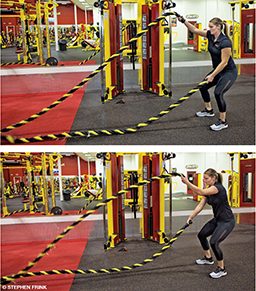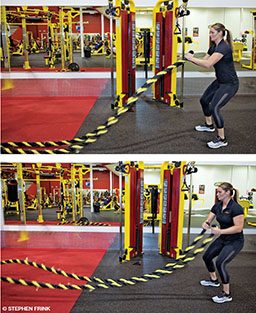Previously reserved for elite athletes, battle ropes are making their way into mainstream fitness facilities. These ropes are useful for getting a full-body workout in a short period. This is particularly true when exercises that address different muscle groups are added during rest periods (as described in this article).
Integration of exercises into what are often called supersets maximizes the work that one can complete in a short time. Supersets are an effective training strategy for those with busy lifestyles and limited time to dedicate to exercise. Scuba divers may fall into this category because their recreational time is divided at least between diving and maintaining fitness to dive.
Even basic battle-rope exercises, such as those included in this workout, require a substantial contribution from stabilizing musculature, and strong stabilizers are a key ingredient to a more relaxing dive. Stabilizers provide a solid foundation for moving around on a rocking boat and finning underwater.
Battle ropes are in available in different diameters. The most common are 1-inch and 1.5-inch ropes (2-inch ropes are available for very fit people). The smaller the ropes’ diameter, the less strength you’ll need to move them. Using 1-inch ropes is a good starting point, especially for smaller-framed individuals.
Battle ropes also come in various lengths. For the activities described in this article, you can take a single long rope and wrap it around a stable object. You could also use two shorter ropes, which work well with a partner on each end. The best approach depends on what (or who) you have available. Studies show that training with a friend improves adherence to an exercise plan. Battle ropes can be a fun way to stay fit (or get fit) along with your dive buddy.
Try to complete three rounds of the following sequence. You may need to use the momentum from your entire body to get the ropes moving quickly. That strategy is safe as long as your movements are controlled. As your strength increases and your body learns the movements, you will isolate more of your extremities during each movement.
Perform an alternate exercise between each rope routine. The alternate exercises you choose should work parts of your body that are not fatigued by the rope exercises. Use any exercise you like, or try the following:
Round 1: Perform your favorite abdominal exercise (crunches, leg lifts or sit-ups, for example). If you dislike sit-ups, try one of the exercises in “No Sit-Ups, No Problem” in Alert Diver, Winter 2017.
Round 2: Choose a lower-back exercise such as superman, simulated swimming, cobra pose or another exercise.
Round 3: Do squats or lunges, or try the barbell back squat (minus the barbell) from “Weight Training for Better Diving” in Alert Diver, Spring 2017.
Always listen to your body. When you notice your form starting to get sloppy (or floppy), take a moment to regroup, then complete the set if possible. It’s OK to take breaks (need for rest is an indicator of hard work), but it’s never safe to exercise with poor form.
Double Slams (20 repetitions)

While grasping the anchored ropes in each hand, begin in an athletic position: knees slightly bent (1/4 squat) with your feet at shoulder width, flat back, glutes out, chest up and weight on the balls of your feet. Raise and lower your hands together to make waves in the ropes. The larger the waves, the more demanding the exercise.
Alternating Slams (10 repetitions on each side)

Start in the same athletic position, grasping the ropes. Quickly raise one hand while lowering the other, then switch. Increase the difficulty by increasing speed and wave size.
Snakes (20 repetitions)

Begin in an athletic position, grasping the ropes with your hands together out in front of you. Keeping your hands together, wave them side to side at waist level. This should create a double snake wave on the floor.
Claps (20 repetitions)

Begin in an athletic stance, grasping the ropes with your hands out to your sides. Quickly bring them together in a clapping manner at waist level. This should create independent wave patterns on the floor.
Circles (10 repetitions, twice)

Begin in an athletic stance with your hands grasping the ropes out in front of you. With your elbows bent and relatively immobile, simultaneously make 10 circles with both hands. Then complete 10 more circles, moving your hands in the opposite direction.
NOTE: To avoid an increased risk of decompression sickness, DAN® recommends that divers avoid strenuous exercise for 24 hours after making a dive. During your annual physical exam or following any changes in your health status, consult your physician to ensure you have medical clearance to dive.
| © Alert Diver — Q4 2017 |